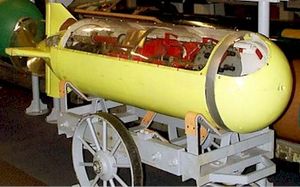
Back FIDO (Torpedo) German Mine Mark 24 French Torpedo FIDO Mark 24 ID Mk24機雷 Japanese Torpeda Mark 24 Polish Mark 24 FIDO Russian Mk 24型魚雷 Chinese
This article includes a list of general references, but it lacks sufficient corresponding inline citations. (July 2023) |
| Mark 24 | |
|---|---|
 Mark 24 acoustic torpedo | |
| Type | Acoustic torpedo |
| Place of origin | United States, Canada, United Kingdom |
| Service history | |
| In service | 1942–1948[1] |
| Used by | |
| Wars | World War II |
| Production history | |
| Designer | Western Electric Company Bell Telephone Laboratories Harvard University Underwater Sound Laboratory[1] |
| Designed | 1942[1] |
| Manufacturer | General Electric Company[1] Western Electric Company |
| No. built | 4000[2] |
| Specifications | |
| Mass | 680 pounds (310 kg)[1] |
| Length | 84 inches (2.1 m)[1] |
| Diameter | 19 inches (48 cm)[1] |
| Effective firing range | 4,000 yards (3.7 km) (10 minutes search duration)[1] |
| Warhead | HBX[1] |
| Warhead weight | 92 pounds (42 kg)[1] |
Detonation mechanism | Mk 142 fuze, contact exploder[1] |
| Engine | Electric, secondary battery[1] |
| Maximum speed | 12 knots (22 km/h)[1] |
Guidance system | preset circle search, passive acoustic[1] |
Launch platform | Aircraft |
The Mark 24 mine (also known as FIDO or Fido) is an air-dropped anti-submarine (ASW) acoustic torpedo developed by the United States during World War II; it was called a mine to conceal its capabilities. The torpedo entered service with the Allies in March 1943; the United States Navy (USN) used it until 1948. Approximately 4,000 were produced. Of the 340 deployed during the war, 204 were fired, sinking 37 and damaging 18 Axis submarines.
- ^ Jolie, E.W. (15 September 1978). "A Brief History of US Navy Torpedo Development". Retrieved 19 June 2013.